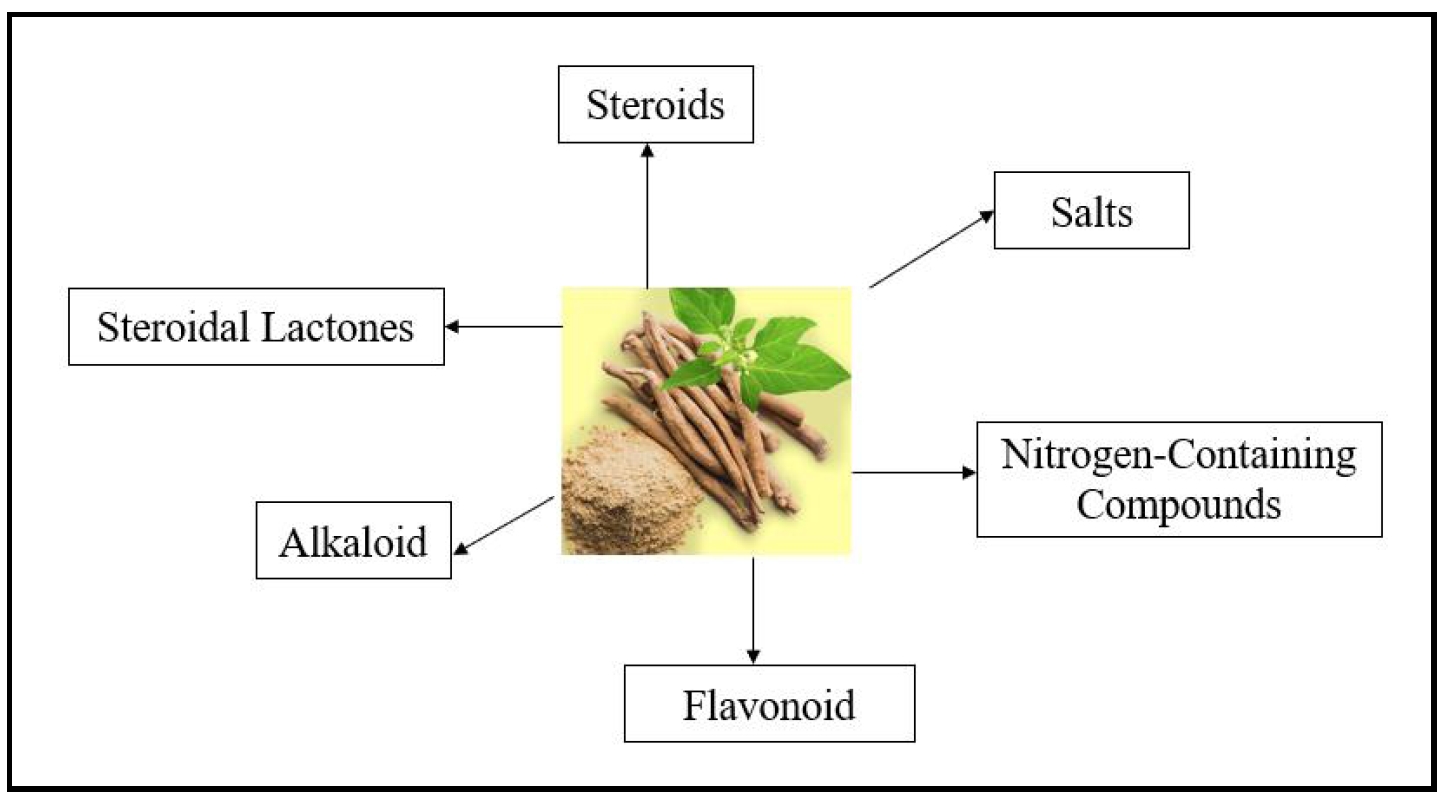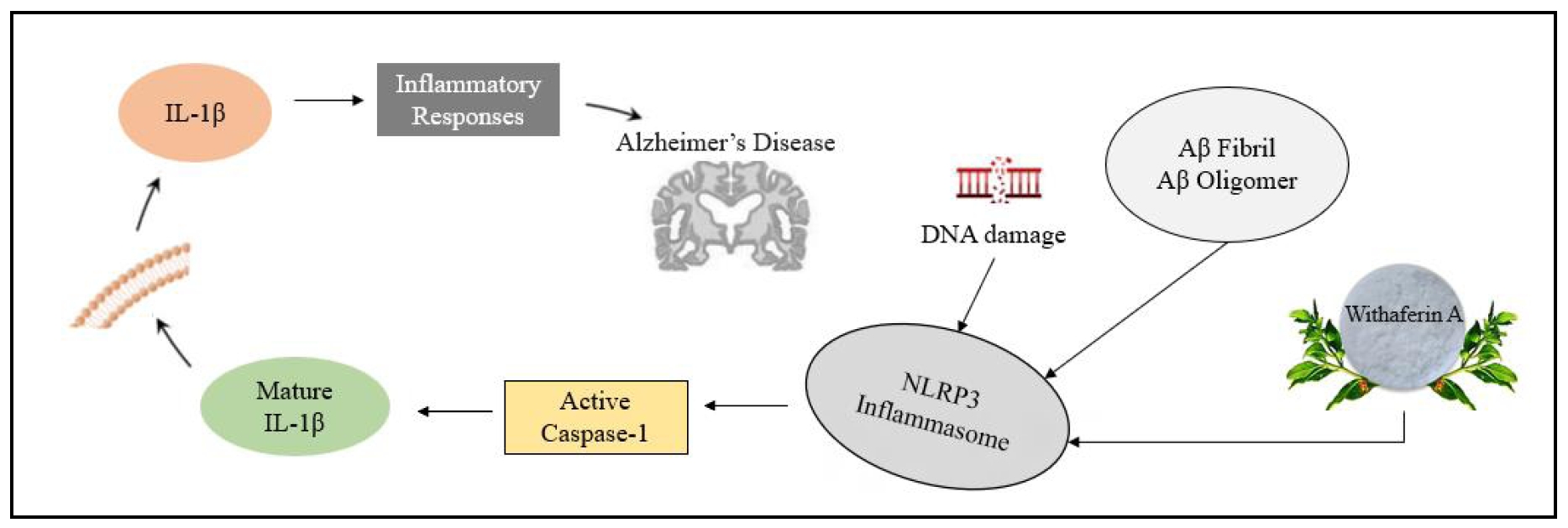Open Access | Commentary
This work is licensed under a Creative Commons Attribution-ShareAlike 4.0 International License.
Withania somnifera: a promising neuroprotective ally against Alzheimer's disease
* Corresponding author: Rajaram Mohapatra
Mailing address: Department of Pharmaceutics, School of Pharmaceutical Science, Siksha 'O' Anusandhan University, Bhubaneswar, Odisha, India.
Email: rajaram.liku@gmail.com
This article belongs to the Special Issue: Evaluating the effects of natural products on cellular and molecular signaling pathways for the management of neurodegenerative diseases
Received: 20 September 2024 / Revised: 09 October 2024 / Accepted: 11 November 2024 / Published: 28 December 2024
DOI: 10.31491/APT.2024.12.157
Abstract
Withania somnifera, or Ashwagandha, shows promise as a neuroprotective agent in Alzheimer's disease (AD), a neurodegenerative disorder characterized by cognitive decline. Bioactive compounds in Ashwagandha, particularly withanolides, exhibit antioxidant, anti-inflammatory, and anti-amyloidogenic properties, positioning it as a potential therapeutic for AD. These compounds target key AD pathologies by modulating amyloid-beta plaque formation and reducing oxidative stress. Preclinical studies reveal that Ashwagandha extracts enhance cognitive function, inhibit amyloid-beta aggregation and decrease neuroinflammation, potentially slowing AD progression. Furthermore, its neurorestorative effects, such as promoting neuronal regeneration and improving synaptic plasticity, contribute to cognitive health. Animal studies demonstrate improved cognitive and behavioral outcomes following Ashwagandha administration, while in vitro research corroborates its role in minimizing neurotoxicity. Although clinical studies are sparse, Ashwagandha's multi-targeted approach makes it a promising candidate for AD management.
Keywords
Withinia somnifera, neuroprotective, medicinal plant, Alzheimer's disease
Alzheimer's disease (AD) is a progressive neurodegenerative disorder characterized by cognitive decline and memory loss, impacting millions of people globally [1]. Despite advances in the understanding of AD pathology—including amyloid-beta (Aβ) plaques, tau hyperphosphorylation, and neuroinflammation—effective therapies are urgently needed [2]. Withania somnifera (Ashwagandha), a traditional Ayurvedic herb, shows promise in AD management due to its antioxidant, anti-inflammatory, and neuroprotective properties. Key bioactive compounds (Figure 1), such as withanolides and withaferin A, help reduce oxidative stress, inhibit plaque formation, and modulate inflammation [3].

Figure 1. Phytoconstituents from Withania somnifera.
Withaferin A (WA) from Withania somnifera shows potential for AD treatment through multiple mechanisms.
It reduces Aβ aggregation, suppresses NF-κB and Hsp90, and inhibits iNOS, thereby decreasing Aβ-induced
neurotoxicity. WA enhances cognitive function by boosting neuroprotective proteins (Hsp27, Hsp70), lowering tau
aggregation, and modulating microglial activity [4]. Berghe et al.
demonstrated that WA alleviates TAR DNA-binding protein-43, a pathological hallmark of AD, while boosting the autophagic
marker LC3BII and its activation of Nrf2, which enhances antioxidant defenses and preserves synaptic
function [5]. Aβ deposition is a hallmark of AD, and withanolide A
from Withania somnifera demonstrates therapeutic potential by reducing Aβ secretion, aggregation, and
neurotoxicity in APP-transfected cells. WA also increases α-secretase and insulin-degrading enzyme (IDE) activity,
thereby promoting Aβ breakdown [6]. Withanamide binds specifically to Aβ
(25-35), limiting fibril formation and neuronal death [7]. Additionally,
withanolide A and withanamides enhance antioxidant enzymes, reducing oxidative stress and mitochondrial
dysfunction, positioning them as promising AD treatments [7].
Current AD treatments, such as acetylcholinesterase (AChE) inhibitors and NMDA receptor antagonists, offer only
temporary cognitive relief. WA from Withania somnifera shows promise as an AD therapy by restoring
cholinergic markers, inhibiting AChE and butyrylcholinesterase (BuChE), and enhancing acetylcholine levels.
Studies show that WA boosts cholinergic neurotransmission and improves cognitive function without affecting other
receptors. At 50 mg/kg, WA provides neuroprotection by increasing dopamine levels, potentially reducing motor
deficits [8]. In AD, Aβ fibrils activate microglia, triggering NF-κB and the
NLRP3 inflammasome, which release pro-inflammatory cytokines (Figure 2)
[9]. WA effectively inhibits NF-κB by targeting IKKβ, thereby reducing
proinflammatory mediators such as TNF-α and IL-1. WA also modulates nitric oxide and COX-2 levels, inhibits iNOS,
and decreases VCAM-1 and ICAM-1 expression, thus curbing microglial inflammation and potentially reducing Aβ
accumulation and neurodegeneration. WA disrupts the CDC37-HSP90 complex and influences AD-related proteins such
as AKT and IKK, underscoring its therapeutic potential in AD treatment [10].

Figure 2. Overview of inflammatory signaling pathways altered by withaferin A.
Nanoparticle-based drug delivery holds promise for AD treatment by enabling targeted transport across the blood-brain barrier (BBB). Withania somnifera extracts rich in withanolides were shown by Sehgal et al. to reduce H2O2- and amyloid-induced cytotoxicity in AD mouse models, enhancing lipoprotein kinase levels [11]. Withaferin A-loaded nanoparticles by Madhu et al. provided sustained neuroprotection with efficient release [12]. Mancini et al. developed mApoE-PA-LIP nanoparticles that act as amyloid-beta "sinks", and enhance Aβ clearance [13]. Further large-scale trials are needed to confirm Ashwagandha's therapeutic potential in AD.
Declarations
Financial support and sponsorship
None.
Conflict of interest statement
All authors declare that they have no competing interests.
References
1. Niu S, Zhang LK, Zhang L, Zhuang S, Zhan X, Chen WY, et al. Inhibition by multifunctional magnetic nanoparticles loaded with alpha-synuclein RNAi plasmid in a Parkinson's disease model. Theranostics, 2017, 7(2): 344-356. [Crossref]
2. Notter T, Aengenheister L, Weber-Stadlbauer U, Naegeli H, Wick P, Meyer U, et al. Prenatal exposure to TiO2 nanoparticles in mice causes behavioral deficits with relevance to autism spectrum disorder and beyond. Transl Psychiatry, 2018, 8(1): 193-204. [Crossref]
3. Vaidya VG, Naik NN, Ganu G, Parmar V, Jagtap S, Saste G, et al. Clinical pharmacokinetic evaluation of Withania somnifera (L.) dunal root extract in healthy human volunteers: a non-randomized, single dose study utilizing UHPLC-MS/MS analysis.J Ethnopharmacol, 2024, 322: 117603. [Crossref]
4. Barua N, Ibn Aziz MA, Tareq AM, Sayeed MA, Alam N, Alam NU, et al. In vivo and in vitro evaluation of pharmacological activities of Adenia trilobata (Roxb.). Biochem Biophys Rep, 2020, 23: 100772. [Crossref]
5. Vanden Berghe W, Sabbe L, Kaileh M, Haegeman G, & Heyninck K. Molecular insight in the multifunctional activities of withaferin A. Biochem Pharmacol, 2012, 84(10): 1282-1291. [Crossref]
6. Tiwari S, Atluri VSR, Yndart Arias A, Jayant RD, Kaushik A, Geiger J, et al. Withaferin A suppresses beta amyloid in APP expressing cells: studies for Tat and cocaine associated neurological dysfunctions. Front Aging Neurosci, 2018, 10: 291-305. [Crossref]
7. Roy A. Role of medicinal plants against Alzheimer's disease. 2018, 11: 205-208. [Crossref]
8. Bhattacharya SK, Kumar A, & Ghosal S. Effects of glycowithanolides from Withania somnifera on an animal model of Alzheimer's disease and perturbed central cholinergic markers of cognition in rats. Phytotherapy Research, 1995, 9.
9. Howes MJ, Perry NS, & Houghton PJ. Plants with traditional uses and activities, relevant to the management of Alzheimer's disease and other cognitive disorders. Phytother Res, 2003, 17(1): 1-18. [Crossref]
10. Purushotham PM, Kim JM, Jo EK, & Senthil K. Withanolides against TLR4-activated innate inflammatory signalling pathways: a comparative computational and experimental study. Phytother Res, 2017, 31(1): 152-163. [Crossref]
11. Sehgal N, Gupta A, Valli RK, Joshi SD, Mills JT, Hamel E, et al. Withania somnifera reverses Alzheimer's disease pathology by enhancing low-density lipoprotein receptorrelated protein in liver. Proc Natl Acad Sci USA, 2012, 109(9): 3510-3515. [Crossref]
12. Madhu S, Komala M, & Pandian P. Formulation development and characterization of withaferin-A loaded polymeric nanoparticles for Alzheimer's disease. BioNanoScience, 2021, 11(2): 559-566. [Crossref]
13. Mancini S, Minniti S, Gregori M, Sancini G, Cagnotto A, Couraud PO, et al. The hunt for brain Aβ oligomers by peripherally circulating multi-functional nanoparticles: potential therapeutic approach for Alzheimer disease. Nanomedicine, 2016, 12(1): 43-52. [Crossref]